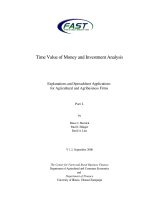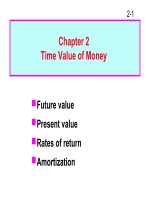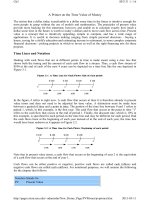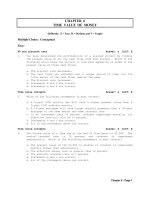slide thuyết trình TIME VALUE OF MONEY AND DCF MODEL
Bạn đang xem bản rút gọn của tài liệu. Xem và tải ngay bản đầy đủ của tài liệu tại đây (290.61 KB, 32 trang )
TIME VALUE OF
MONEY
DCFAND
MODEL
“I think being in love with life is a
key to eternal youth.”
—Doug Hutchison
ThS. Nguyễn Thị Thu Trang
LECTURE CONTENT
• Part 1: Time value of money
•
•
•
•
The importance of time value of money.
Single cash flow formula.
Simple interest and compound interest.
Present value and future value of cash flows.
• Part 2: Discounted cash flow valuation model
ThS. Nguyễn Thị Thu Trang
1
OBJECTIVE LEARNING
Explain
what the time value of money is and why it is so important in the
field of finance.
Explain
the concept of future value, including the meaning of the terms
principal, simple interest and compound interest, and use the
future value formula to make business decisions.
Explain
the concept of present value, how it relates to future value, and
use the present value formula to make business decisions.
ThS. Nguyễn Thị Thu Trang
2
TIME VALUE OF MONEY
Opportunity cost
Risk
ThS. Nguyễn Thị Thu Trang
Inflation
3
CF s at different times are not
directly
comparable.
Why Is The
Time
Value
Which asset
wouldof
you rather own?
Money
Important?
$1,000 now or next year?
Put two CFs in comparable terms.
I SINGLE CASH
FLOW FORMULA
0
1
2
• ••
n-1
n
PVo
FV1
FV2
• ••
FVn-1
FVn
Following:
=PV(1
Present
Value
n
FVPV
=
+
i)
n
FV = Future Value
i = Interest
n = Number of period
I SIMPLE INTEREST
Time
0
10%
1
1__ _____________1____
$100
?
$100110%
Interest Earned
= $10
Amount at the
$100+ $10
end
of each period,
= $110
FVn
1 The interest in each period is earned only using the original Principal.
2
1
?
$100*10%
= $10
$110+ $10
= $120
3
1
1
?
$100*10%
= $10
$120+ $10
= $130
• ‘Interest on interest’- interest earned on reinvestment of previously
COMPOUND
INTEREST
earned interest.
Time
0
1__
$100
Interest Earned
Amount at the
end
of each period,
FVn
10%
1
?
1
$100*10%
= $10
$100+ $10
= $110
2
1
1
?
$110*10%
= $11
$110 + $11
= $121
3
1
?
$121*10%
= $12.1
$121 + $12.1
= $133.1
The interest in each
period is earned using both the original
Principal and the interest you previously earned.
ThS. Nguyễn Thị Thu Trang
FuturG
value ($)
SIMPLE
INTEREST VS.
COMPOUND
INTEREST
Grovvth of $ 100 Oíiglnal amount at 10% per year. Red
shaded area represents the portion of the total that results
from compoundlng of Inlerest
ThS. Nguyễn Thị Thu Trang
8
CHANGING THE COMPOUNDING PERIOD
• So far it has been assumed that the cash flows are yearly (annual
compounding).
• There are however many possible compounding periods that occur
depending on the nature of the asset.
■ Bonds generally pay interest semi-annually.
■ Banks pay often pay interest on a monthly basis.
• Thus, how does this affect FV and PV calculations?
• Steps:
1. The annual interest rate (i) must be converted to a ‘periodic’ rate (i/m).
2. The number of periods in years (t) must be converted to a total number
of compounding periods (t*m).
ThS. Nguyễn Thị Thu Trang
9
CHANGING THE COMPOUNDING PERIOD
•
When the interest is compounded more than once per year:
•
FV formula: FVt = PV(1 + -^)t2m
•
PV formula: PV =
7*
(1+1)t»m
2 Example 1: A lump sum of $100 is invested for a period of three years
with an annual interest rate of 10%.What will its value be 3 years time?
•
•
Example 2:What if interest is compounded semi-annually?
•
•
FV3 = PV (1+i)' = 100(1+0.1)3 = $133.1
FV3 = PV (1+i/m)t*m = 100(1+0.1/2)3*2 =$134
The more frequent the compounding, the more money accumulates.
ThS. Nguyễn Thị Thu Trang
10
TIME VALUE - EXAMPLES
• Suppose you need $10,000 in one year for the down payment on a new car. If you can
earn 7% annually, how much do you need to invest today?
• Suppose you had a relative deposit $10
at 5.5% interest 200 years ago. How much would the investment be worth today?
• You are looking at an investment that will pay $1,200 in 5 years if you invest $1,000
today. What is the implied rate of interest?
• You want to purchase a new car, and you are willing to pay $20,000. If you can invest
at 10% per year and you currently have $15,000, how long will it be before you have
enough money to pay cash for the car?
DIFFERENT TYPES OF CASH FLOWS
Annuity: a level (equal sized) stream of cash flows for a fixed time
■ Ordinary
Annuity: an annuity for which the cash flows occur at the ending of
each period
Time 0 r%
'
■ Annuity
1
2
3
CF
CF
CF
4___________5
CF
CF
Due: an annuity for which the cash flows occur at the beginning of
each period (the first payment occurs immediately)
Time 0
1
r%
2
3
4
CF
5
CF
CF
CF
CF
• Perpetuity: an annuity in which the cash flows continue perpetually
Time 0
ThS. Nguyễn Thị Thu Trang
r%
1
1
CF
2
1
3
ĩ
CF
CF
4
1
CF
r. ,đ_. “•
forever
12
FUTURE VALUE OF AN ORDINARY ANNUITY
Time 0 i%
Time
0
1
i%
1
—
1
1
1
CF
2
...
11
n-1
11
CF
CF
CF
.
CF/(1+i)1 CF/(1+i)2 -
• CF(1 + i) '
n
1
2
...
n-1
n
• FVAn = CF
ThS. Nguyễn Thị Thu Trang
13
CF/(1+Ỉ)
CF/(1+i)n n-1
-
• PVA = -^ + -TL, + ...+ " + -TE(1+01 (1+02
PVA = CF
1+0n-1
1+0n
~l-(l+i)~n~
i
ThS. Nguyễn Thị Thu Trang
14
I ORDINARY ANNUITY - EXAMPLE
0 Starting with her next monthly salary payment, Maria intends to
save $300 each month. If the interest rate is 3% per year, payable
monthly, how much can Maria save after 2 years?
0If you can afford a $2,000 monthly car payment for 2 years, how
much car can you afford if interest rates are 6% compounded
monthly?
ThS. Nguyễn Thị Thu Trang
15
FUTURE VALUE OF AN ANNUITY DUE
Time
1
r% 2 3 4 5
0
CF
CF
CF
CF
CF
• There are 5 payments, but the first payment occurs immediately.
• This is the same as each CF of an ordinary annuity of (5) payments earns one
year interest more.
• In general term, the formula for the FV of an annuity due is:
Annuity due value = Ordinary annuity value x (1+r)
FVADUE = FVAt (1 + r) = CF
ThS. Nguyễn Thị Thu Trang
(1 + r)f - 1
r
(1 + r)
16
PRESENT VALUE OF AN ANNUITY DUE
• There are 5 payments, and the first payment occurs immediately.
Timeis $CF today plus an ordinary annuity of (5-1) payments.
• This
0
r%
1
2
3
4
5
• In general
due is:
CF term, the
CF formula
CF for the PV
CF
CF of an annuity
Annuity due value = Ordinary annuity value x (1+r)
PVADUE = PVA(1 + r) = CF
ThS. Nguyễn Thị Thu Trang
(1 + r)
17
ANNUITY DUE - EXAMPLE
• Suppose you rent a house for $12,000 a year and deposit all the
money received each year at the 10% annual compound interest
savings account, the first deposit occur immediately. Ask how much
money you will have at the end of the third year?
• Kathy’s uncle promised her an allowance of $1,000 per year,
starting today, with a final payment to be made at the beginning of
Year 6. If the interest rate is 7% per year, what is the present value
of these cash flows?
ThS. Nguyễn Thị Thu Trang
18
PRESENT VALUE OF A PERPETUITY
• A perpetuity is the cash flow with inflows or outflows incurred forever.
• We have present value of normal cash flows.
• Khi n à TO thì 1/i(1+i)n à 0, lúc đó:
1
CF
• Using to valuate preference
PVA = CF stock.
= CF
PVAro = CF
ThS. Nguyễn Thị Thu Trang
i
i(1 + 0n -
19
FUTURE VALUE OF MULTIPLE CASH
FLOWS
Time
2345
7%
$100
Q1:You deposit$100 inYear 1,
$200 in Year 2 and $300 in Year 3.
How much will you have in 3 years
with 7% interest per annum.
Q2: How much will it be in 5 years
if you don’t add additional cash?
Solution 1
ThS. Nguyễn Thị Thu Trang
20
FUTURE VALUE OF MULTIPLE CASH
FLOWS
Time
Q1:You deposit$100 inYear 1,
$200 in Year 2 and $300 in Year 3.
How much will you have in 3 years
with 7% interest per annum.
2
7%
1
3
4
5
1--------------1---------------1----------------i----------------1
-----------------1
0
=300(1.07)2
Q2: How much will it be in 5 years
if you don’t add additional cash?
=200(1.07)3
► $131.08
FV at Year
ThS. Nguyễn Thị Thu Trang
$343.47
$245.01
=100(1.07)4
Solution 2
--->
$719.56
21
PRESENT VALUE OF MULTIPLE CASH
FLOWS
Time
You are offered an
investment that will pay
$200 in Yr 1, $400 in Yr
2, $600 in Yr 3 and $800
at the end of Yr 4.You
can earn 12% on similar
investments. What is the
most you should pay for
this one?
12%
$200
$178.57 «
200 (U21
$400
$600
$800
—
=400/(1.12)2
$318.88 ------------------------------__________ ___________
=600/(1.12)3
$427.07
$508.41
<
PV $178.57
ThS. Nguyễn Thị Thu Trang
=800/
(1.12)41
22









